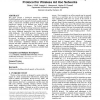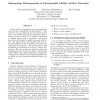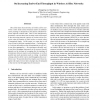266 search results - page 18 / 54 » Capacity bounds for ad hoc and hybrid wireless networks |
IWCMC
2006
ACM
14 years 1 months ago
2006
ACM
This paper presents a load-based transmission scheduling (LoBaTS) protocol for wireless ad hoc networks. Since terminals in these networks may be required to forward unequal amoun...
SRDS
1999
IEEE
13 years 11 months ago
1999
IEEE
Ad-hoc wireless networks have no wired component, and may have unpredictable mobility pattern. Such networks can get partitioned and reconnected several times. One possible approa...
GLOBECOM
2009
IEEE
13 years 5 months ago
2009
IEEE
Abstract--Previous simulations have shown substantial performance gains can be achieved by using hybrid cellular and wireless LAN (WLAN) approaches [1]. In a hybrid system, a proxy...
QSHINE
2005
IEEE
14 years 29 days ago
2005
IEEE
One of the main characteristics of wireless ad hoc networks is their node-centric broadcast nature of communication, leading to interferences and spatial contention between adjace...
ICOIN
2005
Springer
14 years 27 days ago
2005
Springer
Multi-hop ad hoc wireless networks generally use the IEEE 802.11 Distributed Coordination Function (DCF) MAC protocol, which utilizes the request-to-send/clear-to-send (RTS/CTS) me...



